Active volcano


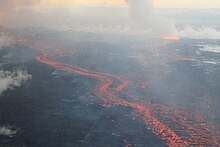
An active volcano is a volcano that has erupted during the Holocene (the current geologic epoch that began approximately 11,700 years ago), is currently erupting, or has the potential to erupt in the future.[1] A volcano that is not currently erupting but could erupt in the future is known as a dormant volcano.[1] Volcanoes that will not erupt again are known as extinct volcanoes.[1]
Overview
[edit]There are 1,350 potentially active volcanoes around the world, 500 of which have erupted in historical time.[2] Many active volcanoes are located along the Pacific Rim, also known as the Pacific Ring of Fire.[2][3] An estimated 500 million people live near active volcanoes.[3]
Historical time (or recorded history) is another timeframe for active.[4][5] The span of recorded history differs from region to region. In China and the Mediterranean, it reaches back nearly 3,000 years, but in the Pacific Northwest of the United States and Canada, it reaches back less than 300 years, and in Hawaii and New Zealand it is only around 200 years.[4] The incomplete Catalogue of the Active Volcanoes of the World, published in parts between 1951 and 1975 by the International Association of Volcanology, uses this definition, by which there are more than 500 active volcanoes.[4][6] As of March 2021[update], the Smithsonian Institution's Global Volcanism Program recognizes 560 volcanoes with confirmed historical eruptions.[7]
Countries with the most Holocene volcanoes, according to the Smithsonian Institution's Global Volcanism Program (as of 2023[update]):[8]
- United States: 165
- Japan: 122
- Russia: 117
- Indonesia 117
- Chile: 91
Countries with the most volcanoes active since 1960 (as of 2023[update]):[9]
- Indonesia: 55
- Japan: 40
- US: 39 (mostly volcanic areas in and around Hawaii, Alaska, and Pacific territories)
- Russia: 27
- Chile: 19
- Papua New Guinea: 13
- Ecuador: 12
As of 2013, the following are considered Earth's most active volcanoes:[10]
- Kīlauea, the famous Hawaiian volcano, was in nearly continuous, effusive eruption (in which lava steadily flows onto the ground) between 1983 through 2018, and had the longest-observed lava lake.
- Mount Etna and nearby Stromboli, two Mediterranean volcanoes.
- Piton de la Fournaise, in Réunion, erupts frequently enough to be a tourist attraction.
As of 2010[update], the longest ongoing (but not necessarily continuous) volcanic eruptive phases are:[11]
- Mount Yasur, 111 years
- Mount Etna, 110 years
- Stromboli, 108 years
- Santa María, 101 years
- Sangay, 94 years
Other highly active volcanoes include:
- Mauna Loa in Hawaii is the largest active volcano in the world. Its summit is more than 4 kilometers (2.5 mi) above sea level, and 17 kilometers (11 mi) above its base in the sea floor.[12]
- Mount Nyiragongo and its neighbor, Nyamuragira, are Africa's most active volcanoes.
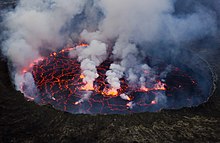
Nyiragongo's lava lake - Erta Ale, in the Afar Triangle, has maintained a lava lake since at least 1906.
- Mount Erebus, in Antarctica, has maintained a lava lake since at least 1972.
- Mount Merapi
- Whakaari / White Island, has been in a continuous state of releasing volcanic gas since before European observation in 1769.
- Ol Doinyo Lengai
- Ambrym
- Arenal Volcano
- Pacaya
- Klyuchevskaya Sopka
- Sheveluch
Holocene volcanoes with large populations within 5 km (3.1 mi):
Michoacan-Guanajuato volcano in Mexico and Tatun Volcanic Group in Taiwan both have more than 5 million people living within 5 kilometers (3.1 mi) of the volcano. Campi Flegrei in Italy and Ilopango in El Salvador both have populations of over 2 million people living within 5 kilometers (3.1 mi) of the volcanoes. Hainan Volcanic Field in China, San Pablo Volcanic Field in the Philippines, Ghegham Volcanic Ridge in Armenia, Dieng Volcanic Complex, in Indonesia, and Auckland Volcanic Field in New Zealand all have over 1 million people living within 5 kilometers (3.1 mi) of each volcano.[13]
By country
[edit]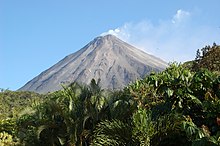
Costa Rica
[edit]- Rincón de la Vieja, a stratovolcano
- Arenal, a stratovolcano
- Poás, a stratovolcano
- Irazu, a stratovolcano
- Turrialba, a stratovolcano
Guatemala
[edit]Source:[14]
- Acatenango, a stratovolcano
- Fuego, a stratovolcano
- Pacaya, a volcanic complex
- Santa María, a stratovolcano
- Tacaná, a stratovolcano
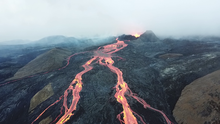

Iceland
[edit]Source:[15]
- Askja, a stratovolcano
- Bardarbunga, a stratovolcano
- Brennisteinsfjoll, crater rows
- Eldey, fissure vent
- Esjufjoll, stratovolcano
- Eyjafjallajokull, stratovolcano
- Fagradalsfjall, fissure vent
- Fremrinamar, stratovolcano
- Grimsnes, volcanic field
- Grimsvotn, caldera
- Heidarspordar, fissure vent
- Hekla, stratovolcano
- Helgrindur, volcanic field
- Hengill, crater rows
- Hofsjokull, fissure vent
- Hromundartindur, stratovolcano
- Katla, fissure vent
- Kolbeinsey Ridge, fissure vent
- Krafla, caldera
- Krysuvik-Trolladyngja, crater rows
- Kverkfjoll, stratovolcano
- Ljosufjoll, volcanic field
- Oddnyjarhnjukur-Langjokull, fissure vent
- Oraefajokull, stratovolcano
- Prestahnukur, fissure vent
- Reykjanes, crater rows
- Snaefell, stratovolcano
- Snaefellsjokull, stratovolcano
- Theistareykir, shield volcano
- Thordarhyrna, stratovolcano
- Tindfjallajokull, stratovolcano
- Tjornes Fracture Zone, fissure vent
- Torfajokull, stratovolcano
- Tungnafellsjokull, stratovolcano
- Vestmannaeyjar, fissure vents


Italy
[edit]Source:[16]
- Campi Flegrei, a caldera
- Campi Flegrei del Mar di Sicilia, a volcanic field
- Colli Albani, a caldera
- Etna, a stratovolcano
- Ischia, a volcanic complex
- Lipari, a stratovolcano
- Marsili, a volcanic complex
- Palinuro, a volcanic compound
- Panarea, a stratovolcano
- Pantelleria, a shield volcano
- Stromboli, a stratovolcano
- Vesuvius, a stratovolcano
- Vulcano, a stratovolcano


Japan
[edit]See list of volcanoes in Japan for more information
Hokkaido
[edit]- Daisetsuzan Volcanic Group
- Mount Eniwa, a stratovolcano
- Mount E, stratovolcano
- Mount Iō, volcanic complex
- Mount Meakan, stratovolcano
- Mount Oakan, stratovolcano/lava dome
- Mount Iō, stratovolcano
- Kuttara Caldera, caldera
- Mashū Caldera, caldera
- Nipesotsu-Maruyama Volcanic Group, composed of stratovolcanoes and lava domes
- Niseko Volcanic Group, composed of stratovolcanoes and lava domes
- Oshima-Ōshima
- Mount Rausu, stratovolcano
- Mount Rishiri, stratovolcano
- Mount Hokkaidō-Komagatake, stratovolcano
- Mount Tarumae, stratovolcano
- Mount Tenchō [ja]
- Mount Usu, stratovolcano
- Mount Yōtei, stratovolcano
Honshū
[edit]- Abu Volcano Group, shield volcanoes
- Mount Adatara, stratovolcano
- Mount Akagi, stratovolcano
- Mount Akandana
- Mount Akita-Komagatake, stratovolcano
- Mount Akita-Yakeyama, stratovolcano
- Mount Asama, volcanic complex
- Mount Azuma, stratovolcano
- Mount Bandai, stratovolcano
- Mount Chōkai, stratovolcano
- Mount Fuji, stratovolcano
- Mount Hachimantai, stratovolcano
- Mount Hakkōda, volcanic complex
- Mount Hakone, volcanic complex
- Mount Haku, stratovolcano
- Mount Haruna, stratovolcano
- Hijiori Caldera
- Mount Hiuchigatake, stratovolcano
- Mount Iwaki, stratovolcano
- Izu-Tōbu volcano Group
- Mount Iwate, stratovolcano complex
- Mount Kurikoma
- Mount Kusatsu-Shirane, stratovolcano
- Mount Myōkō, stratovolcano
- Narugo, stratovolcano
- Mount Nasu, complex volcano
- Mount Niigata-Yakeyama, stratovolcano
- Mount Nikkō-Shirane, stratovolcano
- Mount Norikura, stratovolcano
- Numazawa [ja]
- Mount Ontake, stratovolcano
- Mount Osore
- Mount Sanbe [ja]
- Mount Takahara [ja]
- Midagahara, lava plateau
- Tokachidake Volcano Group, stratovolcano
- Towada Caldera, caldera
- Mount Yake, stratovolcano
- Kita-Yatsugatake (Northern Yatsugatake Volcanic Group)
- Mount Zaō, complex volcano
Izu Islands
[edit]- Aogashima, volcanic island
- Bayonnaise Rocks, volcanic rocks
- Hachijōjima, volcanic island
- Izu-Ōshima, volcanic island
- Kōzushima, volcanic island
- Mikurajima, volcanic island
- Miyakejima, volcanic island
- Niijima, volcanic island
- Sofugan (A.K.A. Lot's Wife), volcanic island, basalt pillar
- Sumisujima (A.K.A. Smith Rocks), volcanic island
- Toshima, volcanic island
- Torishima (A.K.A. Izu-Torishima), volcanic island
- Ogasawara Archipelago:
- Nishinoshima, volcanic island
- Fukutoku-Okanoba, submarine volcano
- Funka Asane
- Iōjima (Iwo Jima), volcanic island
- Kaitoku Seamount, submarine volcano
- Kaikata Seamount
- Kita-Fukutokutai
- Minami-Hiyoshi Seamount, submarine volcano
- Nikkō Seamount, submarine volcano
Kyūshū
[edit]- Wakamiko Caldera [ja]
- Mount Aso (A.K.A. Aso Caldera), caldera
- Fukue Volcano Group
- Ikeda (Part of Ibusuki Volcanic Field), caldera
- Mount Kaimon, stratovolcano
- Mount Kirishima
- Mount Kujū, stratovolcano
- Sakurajima, Somma-stratovolcano
- Lake Sumiyoshi [ja]
- Yonemaru [ja]
- Mount Tsurumi and Mount Garan, lava dome
- Mount Unzen, complex stratovolcano
- Mount Yufu, stratovolcano
Ryūkyū Islands
[edit]- Submarine Volcano NNE of Iriomotejima, submarine volcano
- Iōtorishima, volcanic island
- Kikai Caldera, caldera
- Kuchinoshima
- Kuchinoerabujima
- Nakanoshima, volcanic island
- Suwanosejima
- Yokoatejima, volcanic island


Mexico
[edit]Source:[17]
- Los Atlixcos, shield volcano
- Barcena, pyroclastic cone
- Ceboruco, stratovolcano
- Chichinautzin, volcanic field
- El Chichon, lava dome
- Cofre de Perote, compound
- Colima, stratovolcano
- Comondu-La Purisima, volcanic field
- Coronado, stratovolcano
- Las Cumbres, stratovolcano
- Durango Volcanic Field, volcanic field
- La Gloria, volcanic field
- Guadalupe, shield volcano
- Los Humeros, caldera
- Isla Isabel, tuff cone
- Iztaccihuatl, stratovolcano
- Jaraguay Volcanic Field, volcanic field
- Jocotitlan, stratovolcano
- La Malinche, stratovolcano
- Mascota Volcanic Field, volcanic field
- Michoacan-Guanajuato, volcanic field
- Naolinco Volcanic Field, volcanic field
- Northern East Pacific Rise at 16°N, fissure vent
- Northern East Pacific Rise at 17°N, fissure vent
- Pico de Orizaba, stratovolcano
- Pinacate, volcanic field
- Popocatepetl, stratovolcano
- Cerro Prieto, lava dome
- San Borja Volcanic Field
- Isla San Luis, tuff cone
- San Martin, volcanic field
- Sanganguey, stratovolcano
- Serdan-Oriental, volcanic field
- Socorro, shield volcano
- Tacana, stratovolcano
- Nevado de Toluca, stratovolcano
- Isla Tortuga, shield volcano
- Zitacuaro-Valle de Bravo, volcanic field


Philippines
[edit]Source:[18]
- Ambalatungan Group, a volcanic compound
- Apo, a stratovolcano
- Babuyan Claro, a stratovolcano
- Balut, a stratovolcano
- Mount Banahaw, volcanic complex
- Biliran, volcanic compound
- Mount Bulusan, stratovolcano
- Cabalían, stratovolcano
- Cagua, stratovolcano
- Camiguin, stratovolcano
- Camiguin de Babuyanes, stratovolcano
- Cuernos de Negros, volcanic complex
- Didicas, volcanic compound
- Iraya, stratovolcano
- Iriga, stratovolcano
- Isarog, stratovolcano
- Kalatungan, stratovolcano
- Kanlaon, stratovolcano
- Laguna Caldera, a caldera
- Leonard Range, stratovolcano
- Mahagnao, stratovolcano
- Makaturing, stratovolcano
- Malindang, stratovolcano
- Malindig, stratovolcano
- Mandalagan, volcanic complex
- Masaraga, stratovolcano
- Matutum, stratovolcano
- Mayon, stratovolcano
- Musuan, a lava dome
- Parker, stratovolcano
- Patoc, stratovolcano
- Pinatubo, stratovolcano
- Pocdol Mountains, a volcanic compound
- Ragang, stratovolcano
- San Pablo Volcanic Field, a volcanic field
- Silay, stratovolcano
- Taal, a caldera
United States
[edit]This section is missing information about Hawaii, location of the United States' most-active volcanos. (April 2023) |

Hawaii
[edit]Source:[19]
- Kīlauea, a shield volcano, hotspot volcano
- Mauna Loa, a shield volcano
- Hualālai a shield volcano
- Mauna Kea, a shield volcano
- Kama'ehuakanaloa, a submarine volcano off the coast of Hawaii
- Haleakalā, a shield volcano

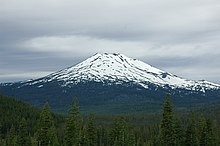
Oregon
[edit]- Boring Lava Field, a volcanic field that intersects with Washington
- Mount Hood, a stratovolcano
- Mount Jefferson (Oregon), a stratovolcano
- Olallie Butte, a shield volcano
- Blue Lake Crater, a maar
- Sand Mountain Volcanic Field, a volcanic field
- Mount Washington (Oregon), a shield volcano or stratovolcano
- Belknap Crater, a shield volcano
- Three Sisters, a shield volcano, stratovolcano(es), and complex volcano
- Mount Bachelor, a stratovolcano and shield volcano
- Newberry Volcano, a shield volcano, stratovolcano, and caldera
- Devils Garden volcanic field, a volcanic field
- East Lava Field, a volcanic field
- Four Craters Lava Field, a volcanic field
- Fort Rock–Christmas Lake Valley basin, a volcanic field
- Davis Lake volcanic field, a volcanic field
- Cinnamon Butte, a volcanic field, lava domes, and cinder cones
- Mount Bailey (Oregon), a shield volcano and tephra cone
- Mount Mazama, a stratovolcano, shield volcano, caldera, and complex volcano
- Wizard Island, a cinder cone and volcanic island
- Merriam Cone, a cinder cone and seamount under Mount Mazama's waters
- Mount McLoughlin, a stratovolcano, shield volcano, and cinder cone
- Brown Mountain (Oregon), a shield volcano and cinder cone
- Pelican Butte, a shield volcano
- Modoc Plateau, a volcanic field and volcanic plateau
- Diamond Craters, a volcanic field and shield volcano
- Jordan Craters, a volcanic field
- Jackies Butte, a volcanic field, shield volcanoes, and cinder cones


Washington
[edit]- Mount Saint Helens, a stratovolcano with lava domes
- Mount Adams (Washington), a stratovolcano
- Mount Rainier, a stratovolcano
- Glacier Peak, a stratovolcano
- Mount Baker, a stratovolcano
- Sherman Crater, a volcanic crater and the most active volcanic crater on Mount Baker
- Tumac Mountain, a shield volcano
- Spiral Butte, a cinder cone and lava dome with a preserved lava flow
- King Mountain (Washington), a shield volcano with a series of spatter cones
- Indian Heaven, a volcanic field and group of shield volcanoes
- Marble Mountain-Trout Creek Hill, a volcanic field
- Boring Lava Field, a volcanic field that intersects with Oregon

California
[edit]- Mount Shasta, a stratovolcano
- Shastina, a stratovolcano and flank cone of Mount Shasta
- Hotlum Cone, a stratovolcanic cinder cone and most recent cone of Mount Shasta
- Misery Hill (California), a stratovolcanic cone near the peak of Mount Shasta
- Sargents Ridge, a stratovolcanic cone of Mount Shasta that is also in a volcano complex with Shastarama Point
- Shastarama Point, a stratovolcanic cone of Mount Shasta that has a crater and lava dome and shares a volcano complex with Sargents Ridge
- Black Butte (Siskiyou County, California), a group of overlapping lava domes that are also a smaller cone of Mount Shasta
- Medicine Lake Volcano, a large shield volcano and caldera east to northeast of Mount Shasta
- Brushy Butte, a poorly-known shield volcano with a cinder cone on its west flank called Timbered Crater
- Chaos Crags, a group of lava domes northwest of Lassen Peak
- Lassen Peak, a large lava dome
- Lassen Volcanic National Park, a volcanic area and volcanic field
- Clear Lake Volcanic Field, a volcanic field full of lava domes and cinder cones
- Mount Konocti, a lava dome
- Mono-Inyo Craters, a volcanic field and volcanic arc within the Sierra Nevada
- Negit Island, an island with a volcanic cone on it
- Paoha Island, an island with a volcanic cone on it
- Panum Crater, a cinder cone with a lava dome
- Mammoth Mountain, a large lava dome
- Long Valley Caldera, a caldera and supervolcano
- Little Walker Caldera, a caldera and possible supervolcano
- Big Pine volcanic field, a volcanic field
- Coso Volcanic Field, a volcanic field
- Cima volcanic field, a volcanic field
- Lavic Lake volcanic field, a volcanic field
- Amboy Crater, a cinder cone
- Pisgah Crater, a cinder cone
- Aiken's Wash, a cinder cone
- Salton Buttes, a group of short and small lava domes southeast of the Salton Sea
- Red Island Volcano, a short lava dome
See also
[edit]- Monogenetic volcanic field – Group of volcanoes, each of which erupts once
- Polygenetic volcanic field – Group of volcanoes, each of which erupts repeatedly
- Category:Active volcanoes
- Category:Potentially active volcanoes
References
[edit]- ^ a b c "Active, dormant, and extinct: Clarifying confusing classifications | U.S. Geological Survey". www.usgs.gov. Retrieved 2023-11-14.
- ^ a b "How many active volcanoes are there on Earth? | U.S. Geological Survey". www.usgs.gov. Retrieved 2023-11-28.
- ^ a b "Volcanoes". European Space Agency. 2009. Retrieved August 16, 2012.
- ^ a b c Decker, Robert Wayne; Decker, Barbara (1991). Mountains of Fire: The Nature of Volcanoes. Cambridge University Press. p. 7. ISBN 978-0-521-31290-5.
- ^ Tilling, Robert I. (1997). "Volcano environment". Volcanoes. Denver, Colorado: U.S. Department of the Interior, U.S. Geological Survey. Retrieved August 16, 2012.
There are more than 500 active volcanoes (those that have erupted at least once within recorded history) in the world
- ^ DeFelice, B.; Spydell, D.R.; Stoiber, R.E. (14 November 1997). "Catalogs of Active Volcanoes". The Electronic Volcano. Dartmouth College. Archived from the original on 2020-01-19. Retrieved 16 April 2021.
- ^ Venzke, E., ed. (2013). "How many active volcanoes are there?". Global Volcanism Program Volcanoes of the World (version 4.9.4). Smithsonian Institution. Retrieved 2 April 2021.
- ^ "Global Volcanism Program | Which countries have the most volcanoes?". Smithsonian Institution | Global Volcanism Program. Retrieved 2023-12-05.
- ^ "Infographic: The Countries With the Most Active Volcanos". Statista Daily Data. 2023-11-15. Retrieved 2023-12-05.
- ^ "The most active volcanoes in the world". VolcanoDiscovery.com. Retrieved August 3, 2013.
- ^ Leontiou, A. (2 November 2010). "The World's Five Most Active Volcanoes". livescience.com. Retrieved August 4, 2013.
- ^ "Where is the largest active volcano in the world? | U.S. Geological Survey". www.usgs.gov. Retrieved 2023-12-01.
- ^ "Global Volcanism Program | What volcanoes have the most people living nearby?". Smithsonian Institution | Global Volcanism Program. Retrieved 2023-11-29.
- ^ "Global Volcanism Program | Guatemala Volcanoes". Smithsonian Institution | Global Volcanism Program. Retrieved 2024-04-07.
- ^ "Global Volcanism Program | Iceland Volcanoes". Smithsonian Institution | Global Volcanism Program. Retrieved 2023-11-23.
- ^ "Global Volcanism Program | Italy Volcanoes". Smithsonian Institution | Global Volcanism Program. Retrieved 2023-11-23.
- ^ "Global Volcanism Program | Mexico Volcanoes". Smithsonian Institution | Global Volcanism Program. Retrieved 2023-11-28.
- ^ "Global Volcanism Program | Philippines Volcanoes". Smithsonian Institution | Global Volcanism Program. Retrieved 2023-12-06.
- ^ "Active Volcanoes of Hawaii | U.S. Geological Survey". www.usgs.gov. Retrieved 2023-11-14.

